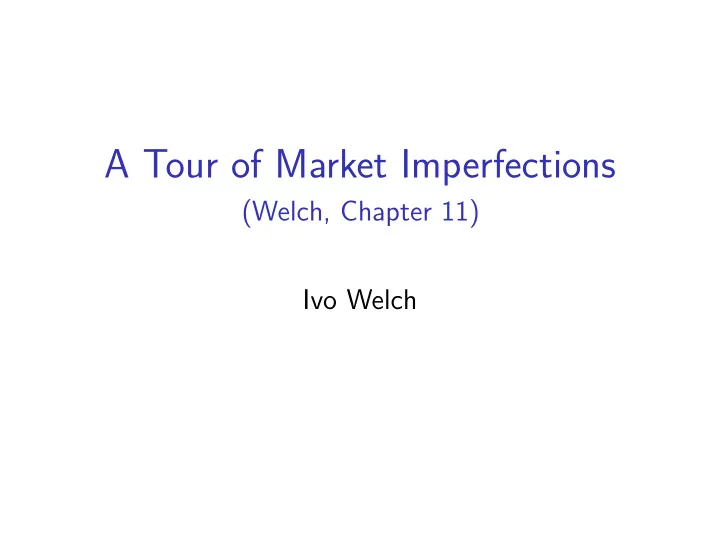

A Tour of Market Imperfections (Welch, Chapter 11) Ivo Welch
Opinions and Disagreements Opinions = Differences in information or information interpretation. Without uncertainty, there can be no information differences. But with uncertainty, there need not be information differences. ◮ For example, roulette has no information differences, but high uncertainty.
Sources Can be irrational differences of opinion, or rational differences: Inside Information ◮ Customer, Supplier, Manager, etc.
Opinions and Disagreements Agents with a lot of uncertainty and disagreements may have to pay (suffer): ◮ higher default premia, ◮ higher risk premia (less for bonds), ◮ information (expertise) premia, ◮ transaction cost premia, ◮ liquidity premia, ◮ etc. The Full Monty!
Disentangling Premia? Small firms suffer it all. A full syndrome, not just one symptom ⇒ Difficult to decompose real-world spreads
Warning Do not confuse ICM-caused differences in E(R) with (PCM-consistent) differences in promised rates. ◮ Almost all entrepreneurs believe that they will succeed (opinion). ◮ They are also overconfident, and thus objectively often bad risks. ◮ But their higher rates often just properly reflects credit risk, not ICMs.
Typical Bond Spreads Most of the yield spread of big corporate bonds is due to higher default probability. ◮ Boston Celtics = 9.4% when T-Bond = 5.6%. ◮ The ∆ of 3.8% is not primarily a higher E(R). ◮ On average (over many firms like the Celtics, recessions and booms), such bonds will probably pay around 6%. ◮ And all premia together may be about 0.4%.
Making Business Making markets is a business. Making markets more perfect or mitigating market imperfections are profitable businesses, . . . as long as you can do so cheaply, . . . and extract some rents from buyers and sellers.
How To Mitigate? What mechanisms can mitigate disagreement? PS: What kind of firms benefit most from this?
Transaction Costs Try to think of roundtrip transaction costs. When you buy a house, the seller pays realtor agents commission, usually 5%. ◮ This does not mean that you, as a buyer, are not implicitly paying for this, too! ◮ If the seller did not have to pay this commission, the seller would accept a lower price. ◮ This transaction cost eats up more than 25% of your equity investment the moment you close.
Relative X-Costs What does it cost to sell a $1 million in Intel Corp shares? What does it cost to sell a $1 million house?
Transaction Costs How do you take care of transaction costs in NPV Assessments?
What is a Liquidity Premium? Liquidity Premium : An extra expected RoR to induce you to hold something that may (suddenly) be tough to resell if/when you are in a hurry.
Liquidity is Strangely Empirically Important Liquidity premium seem more important than they should be. ◮ Examples: LTCM (1998), or the Great Recession (2008). ◮ The liquidity premium seems to have a strong interaction with economy-wide financial slack and aggregate borrowing. ◮ Keep some dry powder! Do not become meat!
Liquidity Provision as Business Making Markets Perfect: ◮ Wall Street I-Bank desks. ◮ Wholesalers ◮ Dealers ◮ Amazon ◮ Specialty Dealers and Funds Simiar: ◮ Moody’s, Credit Bureaus, Sothebys, Zillow
Taxes (See Slides) See c11-3-taxes.pdf Complex and Painful.
Multiple Bond Premia Source : DeJong and Driessen, 2005. Note : U.S. Treasury bonds are exempt from state income taxes.
Graph: DeJong Bond Premia Figure 1: dejong premia
Guess Premia For Equity X-cost premia are lower because of “easy” exchange trading. Liquidity premia are lower (but market crashes?) Risk premia (compensation for risk aversion, based on covariance with the overall investment portfolio) are probably higher. Tax premia are probably lower, because capital gains taxes are lower than interest taxes.
Interaction Effects I give up. With taxes and inflation, life is just too difficult. What shall I do?
Nominal Rates of Return Can the nominal RoR on a bond be negative?
Real Rates of Return Can the real RoR on a bond be negative?
Real After-Tax Rates of Return Can the real after-tax RoR on a bond be negative?
Trasury Bills Today What is the real after-tax RoR on Treasury bills today? You should do this with the prevailing rates instead of the example below. ◮ You pay taxes on the nominal amount in your taxable account (not in your 401k) ◮ At 3.5% nominal interest, you are left with ($103 . 50 − $3 . 50 · 40%) = $102 . 10 nominal dollars at the end of the period.
With Inflation? What are interest rates today? What is the inflation rate today/future? What is the tax rate today/future? ◮ There is a second-order effect: It should be easier to get investors to hold taxable bonds in low-inflation periods, with requisite lower tax penalties.
Recommend
More recommend